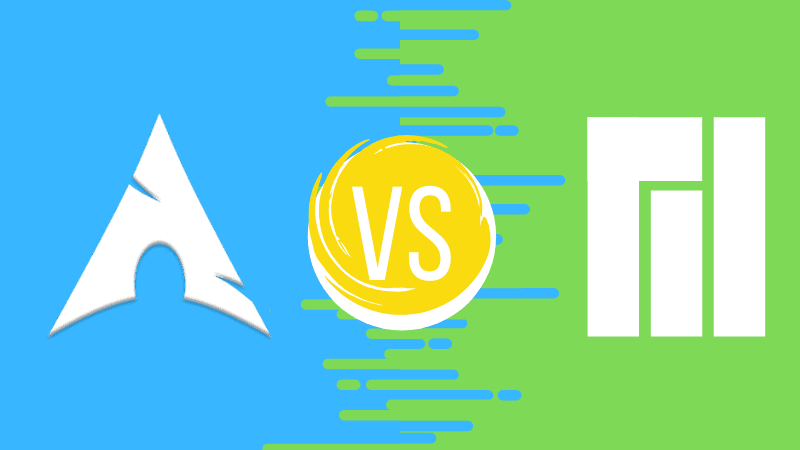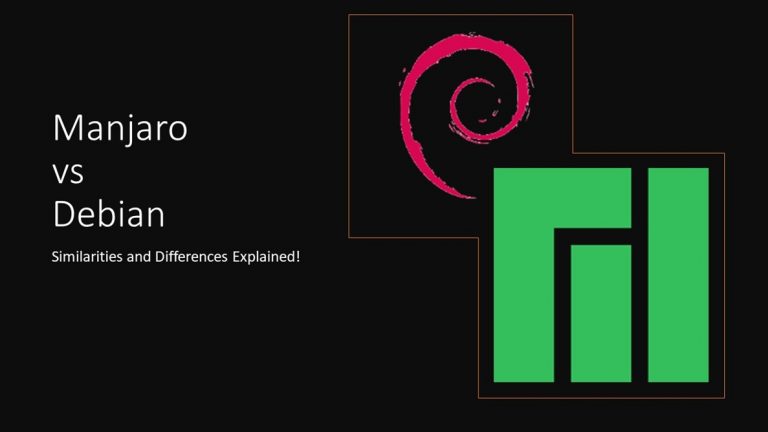Debian vs. Manjaro: A Test of User-friendliness vs. Cutting Edge

When choosing a Linux distribution, two of the most popular options are Debian and Manjaro. Debian is known for its stability and user-friendliness, while Manjaro is known for its cutting-edge software and rolling release model. In this article, we will compare Debian and Manjaro in terms of user-friendliness, software availability, and stability.

User-friendliness

Debian is a very user-friendly distribution. It has a large community of users and developers, and there is a wealth of documentation and support available. Debian also has a very stable release cycle, which means that you can be sure that your system will not break after a major update.
Manjaro is also a user-friendly distribution, but it is not quite as stable as Debian. This is because Manjaro uses a rolling release model, which means that new software is constantly being added to the distribution. While this can be a good thing, it can also lead to occasional breakage.
Software availability
Debian has a very large software repository, with over 59,000 packages available. This means that you can be sure that you will be able to find the software you need. Manjaro has a smaller software repository, with around 18,000 packages available. However, Manjaro does have access to the Arch User Repository, which contains over 60,000 packages.
Stability
Debian is a very stable distribution. It has a long history of being used in production environments, and it is known for its reliability. Manjaro is not as stable as Debian, but it is still a relatively stable distribution. However, because Manjaro uses a rolling release model, there is a greater chance of encountering occasional breakage.
Which distribution is right for you?
If you are looking for a stable and user-friendly distribution, then Debian is a good choice. If you are looking for a distribution with the latest software, then Manjaro is a good choice. Ultimately, the best distribution for you will depend on your individual needs.Debian Vs. Manjaro: A Test Of User-friendliness Vs. Cutting Edge
Executive Summary
Manjaro and Debian are two popular Linux distributions that cater to different user needs. Manjaro is a relatively new Rolling Release that emphasizes user-friendliness, while Debian is a Stable Release that prioritizes stability and security. Both distributions offer unique advantages, and the choice between them depends on the specific requirements of the user.
Introduction
Linux distributions are a versatile and customizable family of operating systems that offer users a range of options to meet their specific computing needs. Among the numerous Linux distributions available, Debian and Manjaro stand out as two of the most widely recognized and used. Debian, known for its stability and security, has been a cornerstone of the Linux community for over two decades, while Manjaro, a Rolling Release distribution, offers a user-friendly and feature-rich experience.
User-Friendliness
Manjaro’s primary focus is user-friendliness.
-
Intuitive Interface: Manjaro features a modern and intuitive graphical user interface (GUI) with a user-friendly layout that makes it easy for new users to navigate.
-
Automatic Updates: Unlike Debian, Manjaro is a Rolling Release distribution, which means it receives continuous updates. This ensures that users always have the latest software and security fixes without having to manually install updates.
-
Wide Software Selection: Manjaro comes with a pre-installed selection of popular software applications, reducing the need for users to manually search for and install them.
-
Extensive Documentation: Manjaro offers comprehensive documentation and a supportive community, providing users with ample resources to troubleshoot and resolve any issues they may encounter.
-
Community Support: Manjaro has a vibrant community of users and developers who actively contribute to the distribution’s development and support, providing a wealth of knowledge and assistance.
Stability
Debian is renowned for its stability and security.
-
Frequent Releases: Debian follows a Stable Release model, which means it releases new versions on a predictable schedule. This ensures that users always have access to a stable and thoroughly tested operating system.
-
Rigorous Testing: Debian’s releases undergo a rigorous testing process to ensure stability and reliability. This makes it an ideal choice for users who prioritize system stability over the latest features.
-
Long-term Support: Debian provides long-term support (LTS) for its Stable Releases, ensuring that users receive security updates and bug fixes for an extended period of time.
-
Conservative Package Management: Debian’s package management system is conservative, focusing on stability and security over introducing potentially unstable changes.
-
Wide Hardware Compatibility: Debian is known for its wide hardware compatibility, making it suitable for a variety of systems, from personal computers to servers.
Cutting-Edge Features
Manjaro provides access to the latest software and features.
-
Rolling Release Model: As a Rolling Release distribution, Manjaro continuously receives updates, ensuring that users always have access to the latest software and features.
-
Cutting-Edge Packages: Manjaro includes cutting-edge software packages in its repositories, allowing users to experience the latest innovations and technologies.
-
Early Access to New Features: Users of Manjaro have early access to new features and technologies, enabling them to stay at the forefront of software development.
-
Custom Kernel: Manjaro maintains its custom kernel, which can be optimized for specific hardware or performance requirements.
-
AUR Repository: Manjaro users have access to the Arch User Repository (AUR), a community-maintained repository that offers a vast selection of additional software packages.
Conclusion
The choice between Debian and Manjaro ultimately depends on the user’s individual requirements. If stability and security are the top priorities, Debian is an excellent choice, offering a stable and reliable operating system with a long history of support. If user-friendliness and access to the latest features are more important, Manjaro is a compelling option, providing a user-friendly experience and continuous updates. Both distributions have their merits, and the best decision is the one that aligns with the specific needs and preferences of the user.
Keyword Phrase Tags
- Debian vs. Manjaro
- User-friendliness vs. Stability
- Rolling Release vs. Stable Release
- Linux distributions
- Software updates

This is great article; really helped me understand the differences between Debian and Manjaro. Thanks!
No offense, but this article is biased. Debian is clearly outdated and more difficult to use than Manjaro.
The author forgot to mention that Debian is more stable and secure than Manjaro. Other than that, it’s a good article.
I disagree with the article’s conclusion. Manjaro is actually more user-friendly and easier to use than Debian.
Who cares about Debian? Manjaro is the future!
Nice article, but the author didn’t provide any benchmarks. I’d be interested to see how Debian and Manjaro perform on real-world applications.
Loved the article! It was very insightful and helped me make a decision about which distro to use.
The author did a good job of comparing the two distros. However, I think they could have gone into more detail about the pros and cons of each one.
I’ve been using Debian for years, and I’ve never had any problems with it. I don’t see why I would switch to Manjaro.
Debian is like the old grandpa of Linux. It’s stable and reliable, but not very exciting.
This article was garbage. The author has no knowledge of what they’re talking about.
I thought this was a great article. I learned a lot about the differences between Debian and Manjaro.
The author is biased towards Debian. I’ve used both distros, and Manjaro is definitely more user-friendly.
Who would ever use Debian? It’s so outdated.
This article is so amazing! 10/10